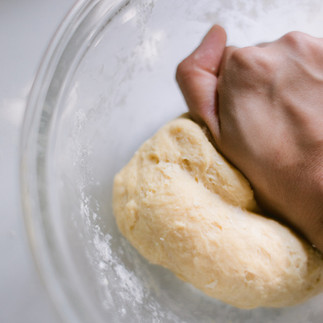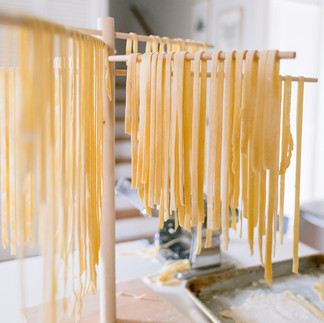Pasta from Scratch
- Brittany Fan
- May 9, 2021
- 3 min read
Homemade pasta is a game changer


There are some things that I don't find worth the trouble to make from scratch rather than picking up from the store--for instance, store-bought funfetti cake mix is mysteriously magical, and I've not found a yogurt recipe that I like and want to invest the time in enough to replace my go-to Trader Joe's Greek yogurt. But homemade pasta is a wholly different thing from its dried, boxed counterpart in the pantry aisle, and worth trying at least once to see if you want to incorporate it into your cooking repertoire. It's also a fun hands-on experience that's great to do with a friend, partner, or kids! I've used this basic dough recipe for pasta noodles, lasagna, and ravioli as well.
Fresh Homemade Pasta
Makes 3-4 servings
Ingredients:
2 cups all-purpose flour
3 large eggs, beaten
1 tablespoon olive oil
1 teaspoon kosher salt
1-2 teaspoons water (as needed)
Additional flour for dusting
Supplies you’ll need: mixing bowl, pasta machine, pasta drying rack or baking sheet/tray
Directions:
In a mix bowl, place in flour and make a well in the middle to add in eggs, olive oil, and salt. Mix together into a shaggy dough.
On a lightly floured surface (or in the bowl if you’re lazy like me), knead the dough for several minutes, eventually it will begin to cohere and even out in consistency. If needed, add 1-2 teaspoons of water to help the dough come together, but lots of kneading is the real key, so don’t add too much!
Cover/wrap the dough and let rest for 30 minutes at room temperature, then roll out and cut using a manual pasta maker. (See notes below about this process.)
Fresh pasta will take less time to cook than dry pasta, so keep an eye on it when boiling--it should be done in about 4-5 minutes.
About rolling out the pasta:
I use a manual pasta machine like this one--there are lots of options out there with a range of pricing, and they all work pretty similarly. There are two mechanisms in the machine: the first one rolls out the flat strips of dough, and the second slices the flat strips into actual noodles.
Once your dough has rested for at least 30 minutes, you’ll want to take a chunk of it (I divide it roughly into 3 or 4 parts) and flatten it a bit to start feeding into the first mechanism in the machine. There should be settings for thickness, and you’ll want to start with a thicker setting for a few passes to get the dough through the machine initially. I usually run it through, and then fold the dough over itself so that the ragged edges and pieces are brought back into the middle, and then guide it through again 1-2 more times--each time, it should get more smooth and consistent. Once it’s rolling smoothly through the machine and coming out evenly, you can adjust the thickness setting to what you’d prefer, and run the strip of dough through it again at that setting to get it thinner.
After you have the flat piece of dough how you want it, run it through the noodle cutting mechanism, which usually has two width settings. After this, take your freshly cut noodles and either spread them out flat on a floured surface or tray, tossing lightly in flour to prevent sticking, or hang them on a pasta drying rack.
Here are some process photos!
























Comments